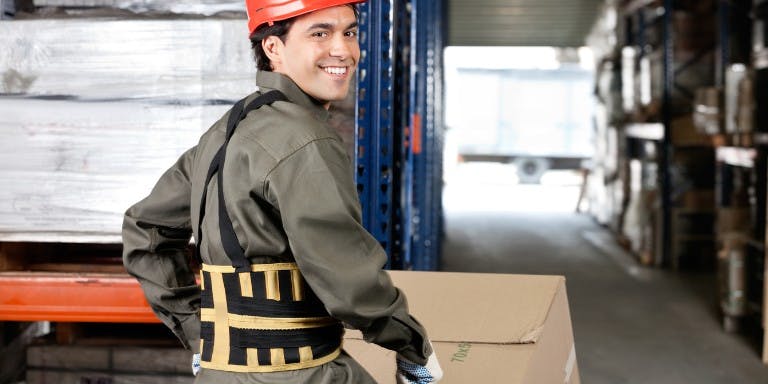First published on Thursday, June 4, 2020
Last updated on Friday, September 12, 2025
As an employer, it’s your duty to keep your staff safe. You must train them correctly so they can perform material handling duties without injury.
You need to understand the dangers that come with manual material handling (MMH).
Failure to do so, could lead to avoidable and serious injuries, along with potential legal trouble.
In this guide, we’ll explain what material handling is, how to ensure your staff avoids injury, and the importance of having the correct safety equipment.
What is material handling?
Material handling or (MMH) is the process of moving or handling objects physically in the workplace.
These tasks are completed by lifting, lowering, pushing, carrying, or restraining. This can range from lifting a singular box of stock to carrying shelving units.
Safe manual handling guidelines
As per the manual handling equipment safety standard, the maximum weight to lift at work in Canada is 23kg. The following guidelines will provide your employees with the safest way to complete the task:
- Plan the lift, take into consideration the route you or the employee will be taking.
- Ensure that only fully-trained staff assist with the task.
- Consider if more than one person will be needed to handle the load.
- If possible, separate the load into more manageable and smaller loads.
- Clear the route of any potential hazards.
- Make sure the unloading area is clear of hazards pre lift.
What makes MMH potentially dangerous?
Employees performing tasks involving MMH or manual handling are always at risk of injury.
As per the Canadian Centre for Occupational Health and Safety (CCOHS), MMH is the most common cause of occupational fatigue and lower back injuries.
Arm, leg, and joint injuries are also commonly caused by manual handling tasks.
The following are common examples of what makes material handling dangerous:
- Load is too heavy for one person to lift.
- Load is situated too high to reach without safety equipment.
- Load is too big or may have a shape that’s too hard to handle.
- Load is wet, slippery or has sharp edges.
Try and eliminate as many manual handling tasks in your workplace as possible – but it won’t be possible to avoid them all.
Your employees will have to carry out manual lifting tasks from time-to-time, ensure you make them aware of safe manual handling guidelines.
How to avoid material and manual handling injuries
The best way to avoid potential injuries in your workplace is to provide training. You must provide sufficient manual and material handling training to all your employees.
Make sure both you and the employee sign off following completion.
You should deliver this health and safety manual handling training to new starters or as an annual refresher. This training should include the correct lifting techniques to use:
- Stand close to the object with your feet roughly shoulder width apart.
- Bend your knees and not your back when reaching down.
- Ensure the object is grasped firmly.
- Keep the heaviest side of the load closest to your body when moving.
- Make sure you don’t twist your back or lean to the side.
- Look ahead when moving, never look down at the load.
- Only change your grip on the load when you’ve stopped moving.
Importance of material handling equipment
Having the correct material handling equipment in your workplace lowers the chance of your staff putting themselves at risk unnecessarily.
Making use of lifting aids, such as forklift, and pallet trucks, mandatory for employees will also lower the risk.
You can choose to implement a no lift policy. This policy states all MMH tasks are to be avoided by employees wherever possible. Be aware, this will only be successful if you have lifting aids available.
Alongside providing material handling equipment, you could also enrol in a CCOHS material handling course to get a certificate. There are a range of courses you could undertake, including courses on the CCOHS website.
What is material handling certification?
Although obtaining a material handling certification isn’t a legal requirement, there’s no harm in completing a handling course.
This will increase your employees’ confidence in you and improve your knowledge when it comes to MMH.
Why is material handling correctly important?
Health and safety in your workplace should be your number one priority. You need to be certain your employees and customers always feel safe.
Keeping your staff safe should be your number one priority. You need to ensure your staff is performing MMH tasks the correct way.
Failure to comply could land you with a range of punishments:
- Ontario: A maximum $100,000 fine for an individual and/or up to 12 months imprisonment, and $1,500,000 fine for a corporation.
- British Columbia: A monetary fine, depending on the number of violations committed.
- Alberta: A monetary fine, with a maximum of $10,000 per day, per violation.
Get help with your material handling today with BrightHR
Keeping your employees safe at work is extremely important. Providing training and clear guidance for manual handling will keep them as safe as possible. Not keeping your staff safe can land you with a hefty fine.
BrightHR has a range of tools that can help keep your workplace safe. Our BrightSafe online health and safety software allows you to manage your material handling, record any accident s and access quality e-learning courses.
Contact us on 18882204924 or book a demo today.

